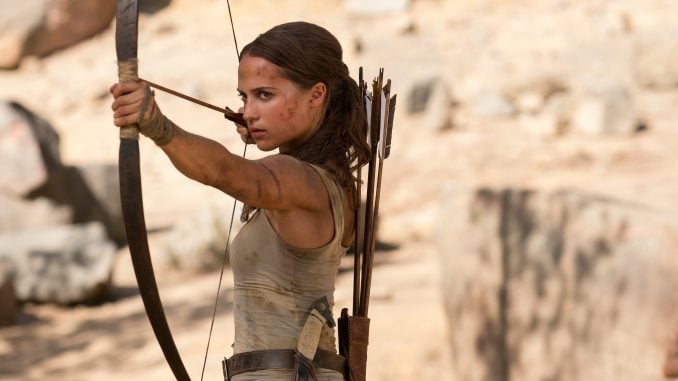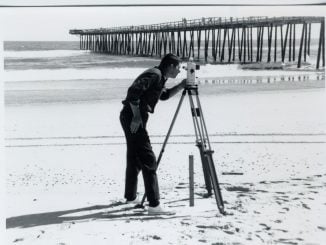
LOS ANGELES — When it was announced that the Swedish actress Alicia Vikander would star in a reboot of “Tomb Raider,” playing the bungee-plunging, chasm-leaping adventurer Lara Croft in a movie that told the story of how she first became…Lara Croft, I’ll confess that my heart didn’t exactly do a flip of anticipation. I’m a major fan of Vikander’s and was glad to see this ferociously gifted and expressive actress reach for A-list megastardom (she was marvelous, two years ago, in her first franchise movie, the shockingly underrated “Jason Bourne”). But the Lara Croft series, in its Angelina Jolie incarnation, always struck me as a hollowly relentless action contraption, and I didn’t want to see Vikander plugged into the machine, reduced to a “high-powered” video game prop.
The exciting surprise of the new “Tomb Raider,” directed by the Norwegian genre specialist Roar Uthaug, is that it doesn’t tamp down Vikander’s inner flame, or the three-dimensionality of her talent; it doesn’t fold and insert her into an overly gymnastic and CGI-happy thrill ride. The movie is full of vine-swinging, bow-and-arrow-shooting, ancient-spirit-meeting action, but most of it is staged on a convincing human scale, one that’s been expertly tailored to its star’s understated directness.
Vikander, small-boned and olive-skinned, has a delicate, contemplative quality that’s strikingly European. In “Tomb Raider,” she doesn’t come off as an action star (the way the toned and implacable Jolie did). She comes off as an imploring, impulsive young woman who’s in over her head but will beat the odds anyway. Her Lara may be the most grounded and believable cinematic video game protagonist I’ve seen (she’s based on the rebooted, origin-story version of the original game), and since we buy her as a person, the movie is actually that much more immersive. Vikander humanizes Lara Croft the way that Harrison Ford humanized her obvious predecessor, Indiana Jones. That doesn’t make “Tomb Raider” anything more than an engrossingly fanciful adventure lark, but it’s that rare thing, a propulsive blockbuster with a bit of heart.

A handful of the movie’s set pieces are lifted right out of the game, like one in which Lara shimmies over the rusty-jointed carcass of a propeller plane, balanced over a mile-high abyss that’s enough to give you vertigo. Yet “Tomb Raider” isn’t beholden to sequences like that. It remains very much its own thing, starting with a “fox hunt” bike race through the streets of London where Lara, who works as a courier, is the volunteer “fox,” wearing a tail and carrying a can that’s dripping chartreuse paint. She has to escape a mass of bike-riding “hunters,” and does it with the kind of split-second ingenuity that will serve her well when she lands on Yamatai, a rocky fairy tale island off the Japanese coast, where her father disappeared seven years ago.
Lara, an heiress who doesn’t act like one, is disconnected from her family’s vast holdings (she doesn’t, as of yet, have access to her wealth), and it’s her relationship with her vanished father, the tender, protective Richard Croft (Dominic West), that provides the film’s unexpected emotional core. We meet Richard in color-desaturated flashbacks, where he stands in the garden of Croft Manor (a place lordly enough to evoke a mini Versailles), saying goodbye to the young Lara as he heads off on yet another open-ended business trip. (What she doesn’t realize is that he’s no mere global tycoon, any more than Indy Jones was just a tweedy archaeologist.)
In outline, this all seems quite standard, even a touch cliche. But now that it’s time, after seven years, to legally declare Richard deceased, Lara discovers that he has left her a trail of bread crumbs. The first raised letter on his crypt leads to his secret study, where she learns where he went — to Hong Kong, and then to Yamatai, all in search of Himiko, an ancient sorceress who was buried alive. What powers the movie — and lifts it — is the way Vikander plays Lara’s yearning to discover the fate of her father not as the usual plot device but as a primal drive. She has to know. Her desire powers every scene.
Much of the effectiveness of “Tomb Raider” comes down to a fresh but old-fashioned idea: the decision by Roar Uthaug to shoot a movie that pivots around omens, curses, jade amulets and Spielbergian rock formations not as a glossy swashbuckling cliffhanger — even though that’s what it is — but as a “realistic” thriller that might actually be taking place. Instead of pummeling us with the outlandish, “Tomb Raider” lures us into suspending our disbelief. Some may find its scrappy, earthbound style a touch drab, but the film’s intense likability is that it’s a kick-ass reverie of feminine power that’s only too happy to be life-size.

That spirit extends from Vikander to the performance of Walton Goggins, who plays Mathias Vogel, the dastardly hunter who’s been stranded on Yamatai for seven years, searching for Himiko’s tomb (for reasons that have something to do with getting off the island and something to do with world domination). Vogel treats his army of workers like chattel, and Goggins, a magnetic actor who projects the lean, hungry anger of vintage-period Jack Nicholson, never hits you over the head with evil; he lets Vogel’s sleazy cruelty seep through his pores. Also noteworthy are Daniel Wu, as the Hong Kong boatman who becomes Lara’s trusty tour guide, and Kristen Scott Thomas as the pearly Croft executive who’s more connected than she looks.
In the end, though, it’s Vikander’s movie. Done right, there’s a special tingle to the image of someone who’s not an action heroine becoming an action heroine. When Lara stands in Himiko’s temple of doom, trying to figure out what to do as spikes jut out of nowhere or a booby-trapped floor falls away, piece by piece, she’s standing in for all of us.
“Tomb Raider,” let’s be clear, is hokum: brisk but derivative, a compendium of jungle-chase pulp spun into something stylishly watchable. Yet when a movie like this one is made with a semblance of the human touch, and when it gives an actress as alive as Vikander a chance to carve out a true character instead of just inhabiting a series of stronger-than-life poses, you walk out feeling honestly entertained rather than jittery with overkill. It’s something that shouldn’t be so rare: escapism that breathes.



